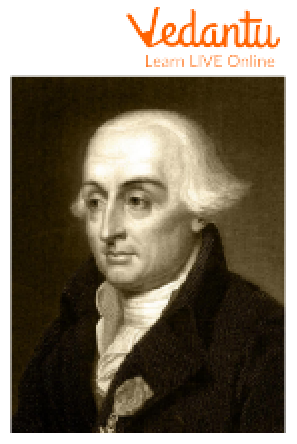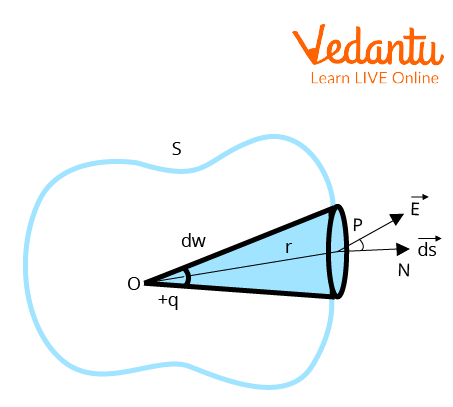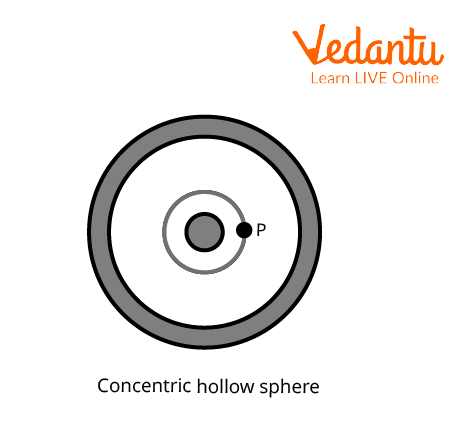




An Introduction to Gauss Theorem
We are aware that there is always a static electric field around a positive or negative electrical charge and that there is a flow of energy tube or flux inside that static electric field. The electric charge is what radiates or emits this flux. The amount of this flux flow now relies on how much charge is coming from it. Carl Friedrich Gauss developed a theorem to determine this relationship. One of the strongest and most practical theorems in the field of electrical research is this one. This theorem allows us to calculate the flux radiated over the surface area surrounding the charge.
History of Carl Friedrich Gauss
Initially, Joseph Louis Lagrange (25 January 1736 – 10 April 1813) introduced the concept and later Carl Friedrich Gauss (German mathematician and physicist who is credited with making important advances in branches of science and mathematics) developed the law in the context of determining the attraction force between the ellipsoids.

Carl Friedrich Gauss (30 April 1777 – 23 February 1855),
Gauss Theorem statement
The net charge in the volume encircled by a closed surface directly relates to the net flux through the closed surface.
Gauss Theorem Formula
The total charge contained within a closed surface is proportional to the total flow contained within it, according to the Gauss theorem. So, if the total flux is \[\phi \] and the electric constant is \[{ \in _0}\], the total electric charge Q contained by the surface is
\[Q = { \in _0}\phi \]
\[ \Rightarrow \phi =\dfrac {Q} {\in_0} \]
where Q stands for total charge within the given surface and \[{ \in _0}\] is the electric constant.
Gauss Theorem Proof
Consider a closed surface S with a charge +q located at a point O within it. On the constrained surface, Point P is located at r from Point O. At point P, the electric field's strength will be

Gauss Theorem Proof
\[\vec E = \dfrac{{1}}{{4{\rm{\pi }}{ \in _0}}}\cdot\dfrac{q}{{{r^2}}}\].......(1)
Electric flux flowing across the region ds that surrounds point P,
\[d\phi \; = \;\overrightarrow {E\;} \cdot\overrightarrow {ds} \]
\[\Rightarrow d\phi \; = \;E\cdot ds\;\cos \theta \]
where \[\theta\] is the angle between E and ds.
Flux crossing the total surface S,
\[\int {\mathop \int_s d\phi \;} = \;\int {\mathop \int_sE\cdot d\cos \theta } \] (2)
Using the value of E from equation (1) in equation (2),
\[\mathop \int_s d\phi \; = \;\phi \]
\[\therefore \phi \; = \;\int {\mathop \int_s\dfrac{1}{{4{\rm{\pi }}{ \in _0}}}\;\dfrac{q}{{{r^2}}}} \]
\[\Rightarrow \phi \; = \dfrac{1}{{4{\rm{\pi }}{ \in _0}}}\;q\;\mathop \int_s \;\dfrac{{ds\cos \theta }}{{{r^2}}}\]
\[\because \left( \dfrac {{ds}\cos \theta}{r^2}=\omega\right)\]
\[\Rightarrow \phi ~=\dfrac{1}{4\text{ }\!\!\pi\!\!\text{ }{{\in }_{0}}}~q\cdot \omega\]
where \[\omega \] is the solid angle. However, in this case, the closed surface S at O has a solid angle equal to \[4\pi \], therefore,
\[\phi \; = \dfrac{{\;1}}{{4{\rm{\pi }}{ \in _0}}}\cdot q\cdot4{\rm{\pi }}\]
\[\phi \; = \dfrac{1}{{{ \in _0}}}\cdot{\rm{q}}\]
Hence Proved.
Limitations of Gauss Theorem
It is only relevant to stationary point charges.
Gauss’ theorem does not describe every aspect of the field. For instance, it says nothing about how an electrostatic field will exert a force on a charge.
It only applies in situations where the inverse square law is followed.
Application of Gauss Theorem
Gauss law is majorly applicable in the following situations:
A uniformly charged infinite straight wire/line charge produces an electric field.
A uniformly charged infinite plate sheet produces an electric field.
A uniformly charged thin spherical shell that produces an electric field.
Solved Examples
1. Find the electric field from the centre of a 6.0 m circle with a 0.2 C charge using the Gauss theorem.
Ans: Given,
\[Q = \;0.2\]
\[r\; = \;0.6m\]
By Gauss' law,
\[\phi \; = \;\oint \vec E\cdot\vec dA\; = \dfrac{{\;q}}{{{ \in _0}}}\]
\[E\; = \dfrac{{\;Q}}{{4\pi {r^2}{ \in _0}}}\]
\[\Rightarrow E\; = \dfrac{{0.2}}{{4 \times 3.14 \times {{\left( {0.6} \right)}^2} \times 8.85 \times {{10}^{ - 12}}}}\; = \;4.99N{C^{ - 1}}\]
2. In the X-Y plane is a massive plane charge sheet with a surface charge density of \[2.0\; \times {10^{ - 6}}\;C{m^{ - 2}}\]. Find the electric field's flux through a circle with a radius of 1 cm that is entirely within the positive x, y, and z planes and whose normal forms a 60-degree angle with the Z-axis.
Ans: Given,
\[\sigma \; = \;2.0\; \times {10^{ - 6}}\;C{m^{ - 2}}\]
\[\theta \; = \;{60^ \circ }\\r\; = \;1\;cm\]
The electric field \[E\; = \;\sigma /2{ \in _0}\] is in the direction away from the planar charge sheet. The field is along the Z-axis at the indicated location.
Gauss's theorem states that the flux
\[\overrightarrow {E\cdot} \delta \vec s\; = \;E\cdot\delta s\;\cos \theta \]
\[\Rightarrow E\cdot\delta s\;\cos \theta \; = \dfrac{{\;\sigma }}{{2{ \in _0}}} \times \pi {r^2}\cos {60^\circ }\]
\[ \Rightarrow \dfrac{{\;{\rm{\sigma }}}}{{2{ \in _0}}} \times \pi {r^2}\cos {60^\circ }\; = \dfrac{{\;2.0 \times {{10}^{ - 6}}C{m^{ - 2}}}}{{2 \times 8.85 \times {{10}^{ - 12}}{{\rm{C}}^2}N{m^2}}} \times 3.14 \times {10^{ - 4}}{{\rm{m}}^2} \times \dfrac{1}{2}\]
\[ \Rightarrow {\rm{E}}\;\; = \;17.5N{m^2}{{\rm{C}}^{ - 1}}\]
3. A sphere with a radius of 1 cm has an evenly distributed charge of \[4 \times {10^8}\] C. A concentric, hollow conducting sphere with a 7 cm radius surrounds it. Calculate the electric field at a point 2 cm from the centre.
Ans: Let's say we need to locate the field at point P. P should be traversed by a concentric spherical surface. Since every point on this surface is equal, the field at every one of them will have the same magnitude and be radial in direction due to symmetry.

Concentric Hollow Sphere
This surface's flux through it,
\[\oint \overrightarrow {E\cdot} \vec ds\; = \;\oint EdS\; = \;E\oint dS\]
\[E\oint dS\; = \;4\pi {r^2}{\rm{E}}\]
According to the Gauss law, this flux equals the charge q that is present inside the surface divided by \[{ \in _0}\]. Thus,
\[4\pi {r^2}{\rm{E}}\; = \dfrac{{\;{\rm{q}}}}{{{ \in _0}}}\]
\[\Rightarrow {\rm{E}}\; = \dfrac{{\;{\rm{q}}}}{{4\pi {r^2}{ \in _0}}}\]
\[ \Rightarrow {\rm{E}}\; = \;9 \times {10^9} \times \left[ {\dfrac{{\left( {\;4 \times {{10}^{ - 8}}} \right)}}{{\;4 \times {{10}^{ - 4}}}}} \right]\]
\[{\rm{E}}\; = \;9 \times {10^5}N{C^{ - 1}}\]
Important Points to Remember
Gauss theorem/law is only applicable to point charges or continuous charge distribution.
The theorem is unaffected by the shape of the surface.
Important Formulas to Remember from Gauss Theorem
The general formula for the Gauss theorem is
\[Q = { \in _0}\phi \]
\[ \Rightarrow \phi =\dfrac{ Q} {\in_0} \]
Due to Infinite Wire, electric Field E is
\[E = \sigma /2\pi { \in _0}\]
Near the plane's charge sheet, the electric field is
\[E\; = \dfrac{{\;\sigma }}{{2\pi r{ \in _0}}}\]
\[E\; = \dfrac{{\;kq}}{{{r^2}}}\]
Conclusion
The Gauss theorem correlates the charges present on the enclosed surface to the 'flow' of electric field lines. The net electric flow is always zero if no charges are contained by a surface. Accordingly, the quantity of electric field lines entering the surface equals the quantity leaving the surface.
FAQs on Gauss Theorem
1. What is the Gauss Theorem and why is it considered important in electrostatics for Class 12 Physics?
The Gauss Theorem states that the net electric flux through any closed surface is equal to 1 divided by the permittivity of free space (ε₀) times the total charge enclosed by that surface. It is important because it simplifies the calculation of electric fields for symmetric charge distributions and is a core part of the CBSE/NCERT Class 12 Physics syllabus (2025–26).
2. Can you state the mathematical form of Gauss Theorem used in CBSE Class 12 exams?
The mathematical form is: \( φ = \frac{Q}{ε_0} \), where φ is the total electric flux through a closed surface, Q is the enclosed charge, and ε₀ is the electric constant or permittivity of free space. This form is frequently used for solving important Physics board questions.
3. Describe one practical application of Gauss Theorem relevant for CBSE board exams.
One practical application is calculating the electric field due to a uniformly charged infinite plane sheet. Gauss Theorem is used here because of symmetry, allowing students to quickly find the field as \(E = \frac{\sigma}{2ε_0}\), where \(\sigma\) is surface charge density.
4. What are the main conditions required for applying Gauss Theorem in Physics problems?
The main conditions are:
- Charge distribution should have symmetry (spherical, cylindrical, or planar).
- Surface chosen (Gaussian surface) must match the symmetry of the charge distribution.
- It is applicable to electrostatic (stationary) charges only.
5. How can students distinguish between linear, surface, and volume charge densities in Gauss Theorem problems?
- Linear charge density (\(\lambda\)): Charge per unit length (“C/m”), used for line charges.
- Surface charge density (\(\sigma\)): Charge per unit area (“C/m²”), used for sheet charges.
- Volume charge density (\(\rho\)): Charge per unit volume (“C/m³”), used for volumetric charge distributions.
6. What are the limitations of Gauss Theorem as per the CBSE Class 12 Physics syllabus?
- It is only directly applicable for symmetrical charge distributions (like sphere, cylinder, or plane).
- Does not give the force on the charge, only the relation between flux and charge.
- Applies strictly to electrostatic (non-moving) charges.
7. What conceptual mistakes do students often make when solving exam questions based on Gauss Theorem?
Common mistakes include:
- Choosing a wrong Gaussian surface (not matching symmetry).
- Ignoring enclosed charge (only including charges inside the surface).
- Using the theorem for dynamic (moving) charges, which is incorrect.
8. Explain how to use Gauss Theorem to determine the electric field inside a hollow conducting sphere for board exams.
Since the net charge enclosed by a Gaussian surface inside a hollow conductor is zero, the electric field at any point inside it is also zero. This is a direct consequence of Gauss Theorem and is important for deriving conceptual questions.
9. How does the Gauss Divergence Theorem in vector calculus relate to the Physics Gauss law studied in CBSE?
The Gauss Divergence Theorem connects the volume integral of the divergence of a vector field to the surface integral over the boundary. In Physics, Gauss law is a special case applied to electric fields and charge distributions, forming a bridge between mathematics and physics in Class 12.
10. Why is the electric flux through a closed surface zero when there is no charge inside, as explained by Gauss Theorem?
When there is no net charge enclosed, the electric field lines entering and leaving the surface are equal in number, resulting in zero net electric flux through the surface according to Gauss Theorem. This concept is often tested through conceptual or HOTS Physics questions.






















